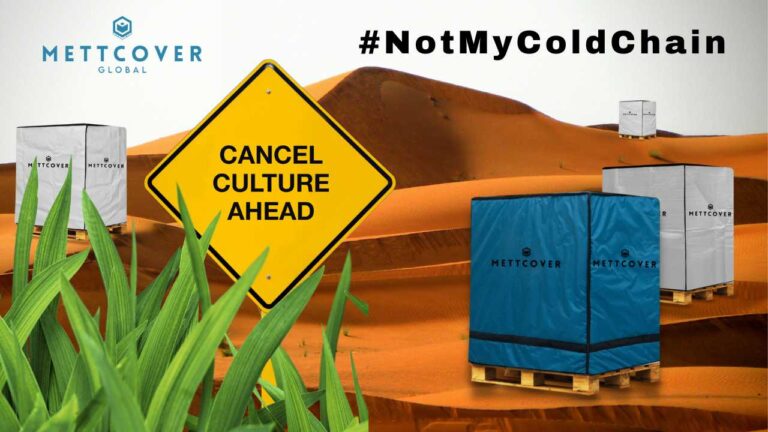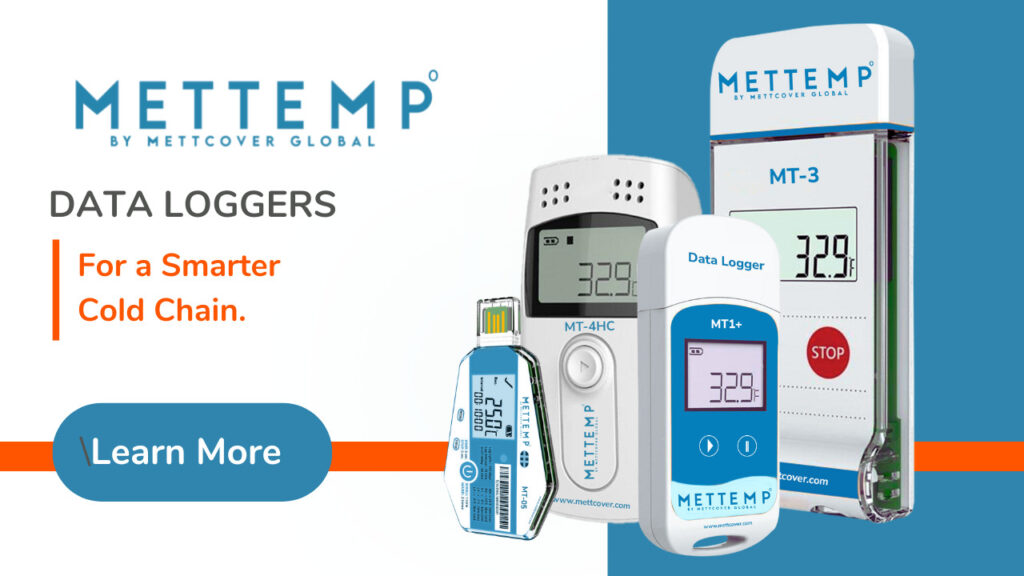#NotMyColdChain. Rethinking Cold Chain Logistics and Embracing Passive Solutions.
- Mettcover Global

In the era of climate crisis, where our planet is teetering on the brink of irreversible damage, it is essential to repurpose industries that contribute significantly to our carbon footprint. Active Cold Chain systems responsible for transporting our temperature-sensitive goods, such as pharmaceuticals and food, are responsible for colossal carbon emissions.
On World Environment Day, it is crucial to reflect on the impact of industries on our planet and seek sustainable alternatives. So, what can be a plausible and an immediate solution to reducing Cold Chain Industry’s Carbon Foot-print? Can passive cold chain insulation systems, or insulated packaging emerge as the heroes of sustainability? Decidedly, “Not the hero we deserve but the one that we desperately need.”
Research has exposed the bitter reality of active cold chain systems. According to the groundbreaking report “Greenhouse Gas Emissions from the Cold Chain” by The Sustainability Consortium, active refrigeration accounts for a staggering 2% of global greenhouse gas emissions.
Just take a moment to let that sink in. But wait, it doesn’t end there.
On average, refrigerated transportation contributes around 750 million metric tons of CO2 emissions annually. That’s equivalent to the emissions of approximately 160 million cars on the road for an entire year. Can you fathom the magnitude of this environmental atrocity?
There is endless science available on this and all of it is correct.
“Environmental Impact of Pharmaceutical Cold Chain Logistics: A Case Study,” exposed the environmental toll of active cold chain systems in the pharmaceutical industry. The carbon emissions associated with refrigeration in the pharmaceutical cold chain have been estimated to exceed 50 million metric tons annually. That’s equivalent to the emissions produced by around 10 million households in a year.
The Impact on the Food Value Chain
The carbon emissions stemming from cold chain logistics have far-reaching ramifications for the food supply chain and environmental health. Excessive emissions contribute to climate change, disrupt ecological balance, and endanger biodiversity. Additionally, the reliance on active cold chain systems has led to quality degradation and increased food waste. As perishable goods are transported through active cold chain systems, the fluctuations in temperature and prolonged exposure to refrigeration technologies often result in compromised product quality. This, in turn, leads to substantial economic losses for businesses and undermines the efficiency of the entire supply chain.
Here’s a table presenting the data on transport emissions and transportation proportions for food transport to UK stores and consumers’ homes:
| Transport Mode | CO2 Emissions as a Proportion of Total Food Transport Emissions (%) | Transportation (tonne-km) as a Proportion of Total Transportation (%) |
| UK Road Total Commercial | 39 | 35 |
| UK Road HGVa | 33 | 19 |
| UK Road Private Cars | 13 | 48 |
| Overseas Road HGVa | 12 | 7 |
| International by Sea | 12 | 0.04 |
| International HGVa | 12 | 5 |
| International Air Freight | 11 | 0.1 |
| UK Road LGVb | 6 | 16 |
| Overseas Road LGVb | 2 | 5 |
| Rail, Inland Waterways | Insignificant | Insignificant |
But on second thoughts and in defense of active refrigeration, maintaining temperature of pallet load is critical too. Shipment load types of frozen food and biologics can lose their integrity in a jiffy if not transported in refrigerated conditions.
In the context of perishable cold chain management, which is the biggest producer of carbon emissions, multiple peer reviewed studies suggest that a strong correlation has been observed between ambient temperature and the prevalence of three enteric pathogens (Salmonella, pathogenic Escherichia coli, and Campylobacter) in Alberta, Canada, as well as Campylobacter in Newfoundland-Labrador.
However, it is important to note that the relationships between temperature and pathogen occurrence are not proportional. In the case of Alberta, the logarithmic relative risk of weekly case counts for Salmonella, Campylobacter, and E. coli increased by 1.2%, 2.2%, and 6.0% respectively, for every 1°C rise in the weekly mean temperature. For Newfoundland-Labrador, the logarithmic relative risk increased by 4.5% for Campylobacter with every 1°C increase in weekly mean temperature.
Several countries have projected the impact of climate change on the occurrence of food poisoning cases. In Australia, a report predicted that by 2050, there could be approximately 79,000 additional cases of food poisoning per year as a result of climate change (Department of Climate Change, 2009).
Microbiological data clearly indicates that if the food industry does not adequately respond to a 2–4°C increase in ambient temperatures by ensuring the temperature of chilled food remains stable, the incidence of food poisoning and spoilage would rise. It is widely accepted, albeit a crude approximation, that bacterial growth rates can double with every 10°C rise in temperature (Gill, 1986). Notably, the effect of temperature on bacterial growth is more pronounced below 10°C, with chilled storage life being halved for every 2–3°C increase in temperature. These findings highlight the importance of temperature control measures in the food industry, particularly in relation to chilled food storage, to mitigate the risks associated with bacterial growth, food poisoning, and spoilage.

Refrigeration has proven to be highly effective in controlling microbe growth and in reducing the spillage in perishables cargo. The below table reflects 2009 data but clearly illustrates the importance of maintaining strict temperatures while transporting or storing food items:
| World Population | Developed Countries | Developing Countries | |
| Population in 2009 | 6.83 billion | 1.23 billion | 5.60 billion |
| Refrigerated Storage Capacity (m³/1000 inhabitants) | 52 | 200 | 19 |
| Number of Domestic Refrigerators (/1000 inhabitants) | 172 | 627 | 70 |
| Food Losses (All Products) (%) | 25 | 10 | 28 |
| Losses of Fruit and Vegetables (%) | 35 | 15 | 40 |
| Loss of Perishable Foods through Lack of Refrigeration (%) | 20 | 9 | 27 |
In recent years, market trends have shown a significant shift towards the adoption of passive cold chain solutions. This can be attributed to several factors. Firstly, there is an increasing emphasis on sustainability and reducing carbon footprint in supply chain operations. Passive cold chain systems, with their reduced energy consumption and reliance on natural cooling methods, align well with these sustainability goals. Additionally, the rising demand for temperature-sensitive pharmaceuticals and biologics has fueled the need for more robust and reliable temperature control solutions. The pharmaceutical industry’s strict regulatory requirements and guidelines, such as the WHO and FDA regulations, further drive the adoption of passive cold chain systems to ensure compliance and maintain product efficacy.
In response to the pressing need for sustainable cold chain solutions, passive insulation systems have emerged as a viable alternative to active systems. These solutions emphasize the use of insulation materials and thermal covers, which require zero energy consumption and can be reused, thereby reducing both carbon emissions and costs.
By leveraging various grades of insulation materials, such as advanced foams and reflective barriers, passive cold chain systems offer effective temperature control while minimizing their impact on the environment. These solutions not only address the carbon emissions associated with active systems but also promote resource conservation and a circular economy.

Passive solutions have gained traction due to their potential to significantly reduce energy consumption and carbon emissions. The International Institute of Refrigeration (IIR, 2009) reveals that developing countries could benefit immensely from the adoption of passive systems. These systems have the potential to decrease the loss of perishable foods due to a lack of refrigeration by up to 9%, thereby enhancing food security and reducing economic losses.
The Benefits of Passive Cold Chain Solutions
Low on Energy but High on Environment.
Research has consistently demonstrated the superior energy efficiency of passive cold chain systems compared to active systems. According to a comprehensive life cycle assessment (LCA) conducted by Shehabi et al. (2018), passive systems exhibited significantly lower energy consumption due to their reliance on natural cooling mechanisms and the absence of active refrigeration. The study revealed that passive systems consumed up to 70% less energy, resulting in substantial reductions in greenhouse gas emissions and contributing to climate change mitigation.
Reduced Maintenance & Zero Technical Failures
Passive cold chain systems offer inherent advantages in terms of maintenance and complexity, thereby reducing resource consumption. Unlike active systems, which rely on compressors and mechanical equipment, passive systems leverage insulation, phase-change materials, and ice packs to maintain the desired temperature range. Hu et al. (2017) explored sustainable cold chain solutions for fresh food delivery and emphasized the simplicity of passive cooling technologies like evaporative cooling and zeolite cooling. The study indicated that passive systems not only required fewer maintenance interventions but also boasted longer lifespans, effectively minimizing waste generation and promoting sustainable practices.
Lower Costs. A Thermal Pallet Cover made with engineered insulation material costs only a fraction of active refrigerated unit.
One of the most compelling advantages of passive cold chain systems lies in their cost-effectiveness compared to active systems. Active systems necessitate substantial upfront investments in refrigeration units, coupled with ongoing operational expenses for energy consumption and maintenance. In a comprehensive environmental and economic life cycle assessment by Azapagic et al. (2015), passive cooling systems for vaccine storage and transportation emerged as the more financially viable option. The study found that passive systems incurred significantly lower lifecycle costs, making them an attractive alternative for pharmaceutical supply chains.
Aviation Supply Chain and Sustainability
Given the aviation industry’s crucial role in the global transportation of pharmaceuticals, addressing sustainability concerns within the aviation supply chain becomes paramount. The energy-intensive nature of active cold chain systems utilized in aircraft cargo holds contributes significantly to the industry’s environmental impact. Integrating passive cold chain solutions represents a significant stride toward sustainability.
Implementing passive cooling solutions in the aviation industry has garnered attention as a powerful strategy for reducing energy consumption and emissions. Chong et al. (2019) investigated the viability of passive cooling containers in aviation. Their study showcased how containers equipped with phase-change materials and insulated packaging effectively maintained pharmaceuticals’ required temperature range during air transportation. Embracing such solutions enables the aviation industry to minimize its carbon footprint and actively contribute to sustainable development.
Optimized Cold Chain Packaging
In addition to adopting passive cooling technologies, optimizing pharmaceutical packaging can further enhance the sustainability of cold chain systems in aviation. Innovations in packaging, such as the use of lightweight materials and improved insulation, contribute to reduced shipment weight, resulting in fuel savings and lower emissions. Rahim et al. (2020) emphasized the significance of eco-friendly packaging materials and waste reduction while preserving product integrity during transportation of temperature-sensitive products, including pharmaceuticals.
You can REUSE & RECYCLE Thermal Pallet Covers & Blankets.
Again and Again, and Yet Again…
Reusability and recyclability of insulation materials present in passive solutions promote resource efficiency and minimize waste generation. This, in turn, contributes to the overall economic viability of the cold chain logistics sector. Cold chain Packaging systems like Air cargo Covers and Thermal Drum Covers offer cost savings for businesses by reducing energy consumption and eliminating fuel requirements. This leads to improved profitability and operational efficiency in the long run.
On World Environment Day, it is crucial to reflect on the impact of industries on our planet and seek sustainable alternatives. A paradigm shift towards passive cold chain solutions is essential to mitigate the carbon footprint of the industry. By considering the alarming statistics and embracing sustainable practices, stakeholders in the cold chain sector can contribute to a more environmentally friendly and economically viable future. It is imperative that governments, businesses, and consumers work together to support and adopt these passive solutions for a greener and more sustainable cold chain industry.
Learn how you can make your cold chain resilient & sustainable. Get in Touch with a Mettcover Cold Chain Expert.




